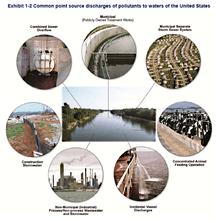Point source pollution

Water pollution point sources

Air pollution point sources
A point source of pollution is a single identifiable source of air, water, thermal, noise or light pollution. A point source has negligible extent, distinguishing it from other pollution source geometries. The sources are called point sources because in mathematical modeling, they can be approximated as a mathematical point to simplify analysis.[1] Pollution point sources are identical to other physics, engineering, optics, and chemistry point sources and include:
- Air pollution from an industrial source (rather than an airport or a road, considered a line source, or a forest fire, which is considered an area source, or volume source)[2]
- Water pollution from factories, power plants, municipal sewage treatment plants and some farms (see concentrated animal feeding operation).[3] The U.S. Clean Water Act also defines municipal separate storm sewer systems and industrial stormwater discharges (such as construction sites) as point sources.[4]
- Noise pollution from a jet engine[5][6]
- Disruptive seismic vibration from a localized seismic study[7]
- Light pollution from an intrusive street light[8]
- Radio emissions from an interference-producing electrical device
See also
References
- ↑ van Leeuwen, C.J. (2010). Risk Assessment of Chemicals: An Introduction, 2nd Ed. Dordrecht, The Netherlands: Springer. ISBN 978-1-4020-6101-1.
- ↑ "Air Pollution Emissions Overview". Washington, D.C.: U.S. Environmental Protection Agency. 2016-06-08.
- ↑ Harrison, Roy M., ed. (2001). Pollution: Causes, Effects and Control (4th ed.). Cambridge, UK: Royal Society of Chemistry. p. 2. ISBN 0-85404-621-6.
- ↑ United States. Clean Water Act. Section 402(p), 33 U.S.C. § 1342(p).
- ↑ "Point sources". Sound Waves. University of Southampton. Retrieved 2018-01-24.
- ↑ Brüel & Kjær, Nærum, Denmark. "Environmental Noise Propagation". Noise Pollution Clearinghouse. Montpelier, VT. Retrieved 2018-01-24.
- ↑ Stähler, Simon & Hosseini, Kasra & Zhang, Ran & Sigloch, Karin (2014). "Estimating the uncertainty of seismic point source solutions". Conference: EGU General Assembly 2014, held 27 April - 2 May, 2014 in Vienna, Austria, id.9911.
- ↑ "Light Pollution Sources". Night Skies. U.S. National Park Service. Retrieved 2018-01-24.
This article is issued from
Wikipedia.
The text is licensed under Creative Commons - Attribution - Sharealike.
Additional terms may apply for the media files.